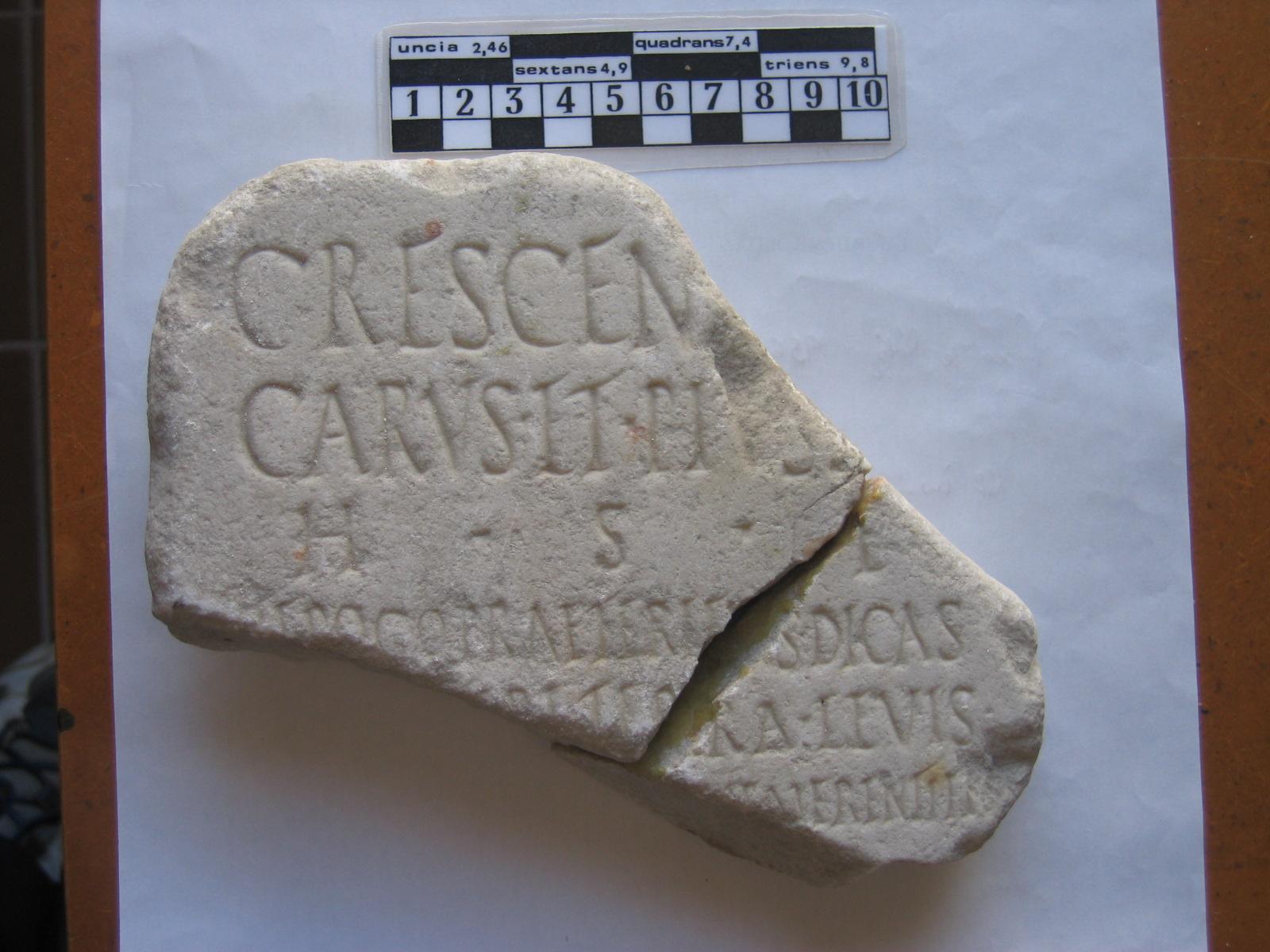(Español) CA7
Reference HEp 2005, 111 | Description | Lyrics | Location | Chronology | Epigraphic edition | Translation | Apparatus | Comentary | Type of verse | Text divided into verses and metric signs | Images | Bibliography | Link to DB | Author |
Description
- Idno filename 22/01/0067
- Type of inscription: Sepulcralis
- Support: Placa
- Material: Mármol Material Description: Whitish colour.
- Conservation status: broken into several pieces of which two are preserved that can be joined together. The top right-hand corner and the bottom left have been lost. The three edges conserved have been bevelled down.
- Dimensions height/width/depth (cm): 13/16.2/3
-
Epigraphic field:
- Layout: Triangular interpunction signs with the vertex facing downwards. At the end of l. 5 there is an interpunction sign as if to signal the end of the verse-line.
- Conservada
Lyrics
- Font:Libraria
- Letter size:Ll. 1-3: 1,9/1,6. Ll. 4-5 carmen: 1,1/ 0,8 cm
- Description of the letters:With curved horizontal strokes.
Location
- Place of discovery: Found in the Roman monument demolished above the hypogeum excavated in Cádiz in 1933 QUINTERO 1934, 10, located in the area cleared to make way for the Fábrica Nacional de Torpedos.
- Geolocation
- Conservation location: It was delivered by the excavator himself on 21 January 1940 to the Museo de Cádiz, where it remains.
- Inventory number: 4.627
- Location with Modern Nomenclature España / Cádiz
- Location with Old Nomenclature Hispania / Baetica / Gaditanus / Gades
Chronology
- Inscription's dating: Between year 170 and year 199
Type of verse
- Type of verse: Dactílico (pentámetro)
- Verse/line correspondence: No
- Prose/verse distinction: Si
Epigraphic edition
Crescen[tius]
carus ▴ et ▴ piụs [▴] s[uis]
H(ic) ▴ S(itus) ▴ E(st)
Ṭe [▴] rogo [▴] praeterieṇs ▴ dicas
5 [sit] ṭịḅi ▴ terra ▴ levis ▴
[-18?- be]ṇẹmerenti ▴ et
[‑ ‑ ‑ ‑ ‑ ‑]
Text divided into verses and metric signs
Te rogo praeteriens dicas: ‘sit tibi terra levis’. lkl|lkk|l/l|l||lkk|lkk|~
Translation
“Crescentius, dear and dutiful to his own, lies buried here. I ask you, passer-by, to say: 'may the earth rest lightly on you.’ [...] to her (husband?), who was well deserving and...”
Bibliography
Quintero 1934, 10, tab. VIII (Vives, ILER 3762); Romero de Torres 1934, 540; González Fernández, IRCa, 402, im. CXIV; Gómez Pallarès – del Hoyo – Martín Camacho 2005, 215–218 (cum im. phot.) (HEp 2005, 111); del Hoyo in Fernández Martínez, CLEB, CA7 cum im. phot. Cugusi 2012, 58. – Cf. Hernández Pérez 2001a, 245.
Apparatus
1 Crescen[s] GONZÁLEZ FERNÁNDEZ. – 2 carus · et · pius [·] s[uis] GÓMEZ PALLARÈS – DEL HOYO – MARTÍN CAMACHO; CARVS II QUINTERO; carus et pius GONZÁLEZ FERNÁNDEZ. – 5 SIC TIBI QUINTERO, [sit ti]bi GONZÁLEZ FERNÁNDEZ. – 6 AIERENT H.L.S QUINTERO; TERENTIEN ROMERO DE TORRES; [bene] merenti GONZÁLEZ FERNÁNDEZ.
Comentary
In l. 1 there is enough space for four letters. If we completed Crescen[s] it would be necessary to add an interpunction and two or three letters, apparently Crescen[ · ser(vus)], what would be odd; therefore, although it is more rare in Hispania, we should read Crescen[tius],as we read in S. Sebastiao do Freixo (CIL II 5235).
This is a pentameter with the formula in scriptio plena, in contrast with other inscriptions from the area in which it appears in fully abbreviated form: T. R. P. D. S. T. T. L. (González Fernández IRCa, no. 115, 233) or as a mixed formula with both abbreviated and fully developed words (González Fernández IRCa, no. 38, 148, 249). In its formation it has been contaminated by similar formulae: te precor ut dicas (CLE 1457), et precor ut dicas (CLE 2092), dic rogo qui transis (CLE 1452), with an extra foot in the first hemistich, either the first dactyl: te rogo, or the last spondee: dicas (cf. CA3).
Hapax formula in l. 2 (González Fernández IRCa, 306, indexes) as opposed to c(arus/a) s(uis), frequently written K.S., and P. S. At the beginning of l. 5 there is space for about six letters, an indentation of three plus sit. There is an interpunction sign after levis, which may indicate the end of the carmen. In view of what is preserved (nemerenti.et), it can be assumed that there was another elogium of the type incomparabili, etc.
Author
- Author:J. Del Hoyo Calleja
- Last Update2023-11-21 11:51:31
- Autopsy date:2003
You can download this




